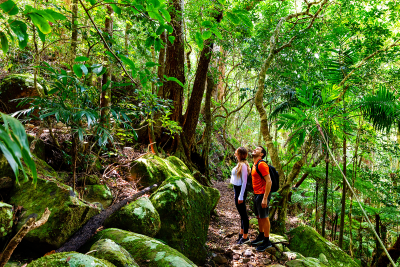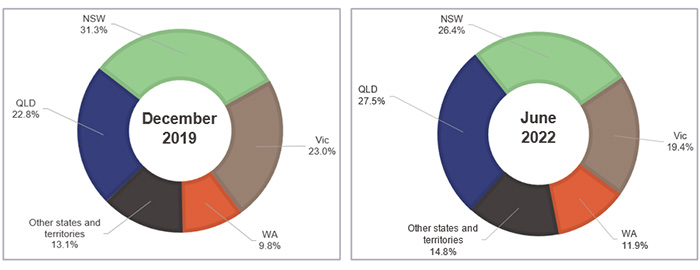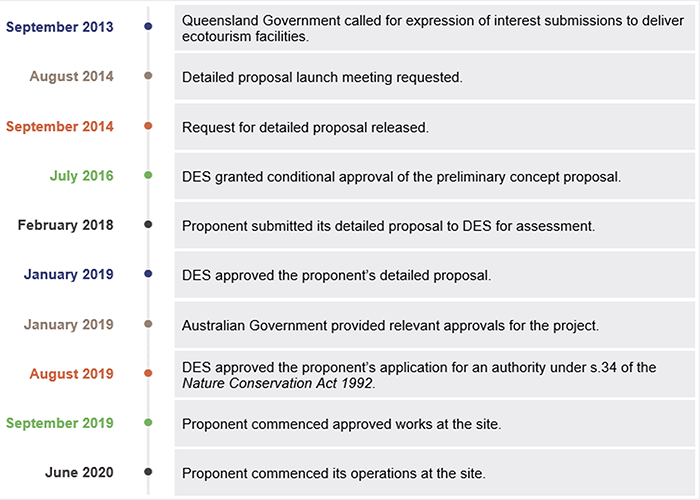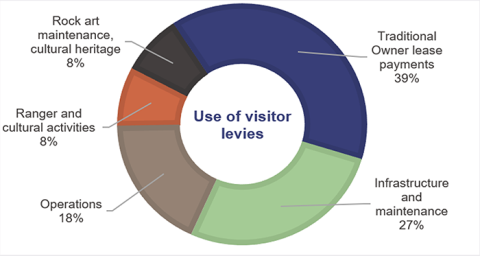Overview
Blessed with world-class natural and cultural assets, Queensland has competitive advantage over many other locations. The Queensland Government’s vision is to capitalise on this and make it a world leader in ecotourism, while ensuring conservation and partnering with Traditional Owners of the land. The state’s tourism and environmental entities face a difficult challenge between protecting the unique natural environment and deriving economic benefit for Queenslanders.
Tabled 9 May 2023.

Report on a page
Ecotourism is ecologically sustainable tourism, with a primary focus on experiencing natural areas, that fosters environmental and cultural understanding, appreciation, and conservation. Blessed with world‑class natural and cultural assets, Queensland has competitive advantage over many other locations. The Queensland Government’s vision is to capitalise on this natural advantage and make Queensland a world leader in ecotourism, while conserving its natural and cultural assets and partnering with Traditional Owners of the land. We examined the effectiveness of the state’s tourism and environmental entities in developing sustainable ecotourism in Queensland.
Direction for growing ecotourism
In November 2022, the Department of Tourism, Innovation and Sport released a broader tourism strategy, Towards Tourism 2032 – Transforming Queensland’s visitor economy future, which recognises the opportunity for the state to lead the world in sustainable tourism and ecotourism experiences. It has specific actions for developing the ecotourism sector. But the Queensland Government has no statewide policy on ecotourism that clearly defines how the state’s tourism and environmental entities will work towards its vision, inhibiting ecotourism planning and coordination. Recognising the often competing roles and priorities of responsible entities, there is a need to establish a definition of ecotourism and what it means to the state – both within and outside Queensland’s protected areas. The entities have also not developed a clear roadmap to direct how they will act to achieve the state’s ecotourism vision.
Planning and coordinating ecotourism
Clarity of policy, definition, and action is necessary for the entities and the tourism industry to effectively plan and coordinate managing the difficult balance between conservation and ecotourism. The tourism industry needs clarity and certainty to enable it to make informed commercial decisions and develop viable initiatives, which will not only benefit the industry but also contribute to growing the state’s economy.
A statewide policy on ecotourism will allow entities to align ecotourism-related strategies and plans with government’s ecotourism priorities, and identify differences in priorities and tolerances for developments in and outside protected areas. Strategies and plans should include investment priorities for government funding, and clear goals and measurable success indicators to monitor and report progress.
Identifying ecotourism opportunities
Until recently, identifying ecotourism opportunities was reactive and unstructured. No ecotourism investment strategy meant state investment has been based on limited understanding of development priorities. A Tourism Infrastructure Development Framework is being prepared, under which the state will identify and assess tourism infrastructure projects and initiatives. In conjunction with a statewide policy, the framework should provide more rigour and direction.
Managing ecotourism in protected areas
The Department of Environment and Science has a robust process for assessing and approving proposals in protected areas (‘on park’ developments). Its processes reflect state and Commonwealth environmental and planning legislative requirements. Consultation with Traditional Owners is an integral part of any ecotourism facilities proposal in protected areas. Industry feedback is that the process is lengthy and complex, and often costly. Greater government guidance and support would assist industry in making informed decisions. It would assist proponents in navigating the various legislative and approval processes and enhance their ability to partner with Traditional Owners.

1. Audit conclusions
The state’s tourism and environmental entities face a difficult challenge between protecting Queensland’s unique natural environment and deriving economic benefit for Queenslanders. Historically, the balance has tended to lean in favour of conserving protected areas (national parks, conservation parks, nature refuges, and special wildlife reserves) with relatively few ecotourism proposals progressing to successful development and operation.
The Department of Tourism, Innovation and Sport and the Department of Environment and Science (the departments), Tourism and Events Queensland, and the tourism industry do work together to overcome these challenges in meeting the state government’s vision of making Queensland a world leader in ecotourism. However, their success to date has been limited. Since 2013, the Department of Environment and Science has approved 3 ecotourism facilities in national parks, with 2 more in development. The approval processes and delivery of these developments were lengthy, complex, and costly. The absence of a statewide policy on ecotourism means it is difficult to measure the development of ecotourism outside Queensland’s protected areas.
Success in effectively balancing the state’s environmental protection and ecotourism development priorities is considerably inhibited by the departments not proactively clarifying the government’s policy, priorities, and tolerances for ecotourism developments within and outside protected areas. Successive governments have had different views on how to approach ecotourism. Legislation has changed, 'ecotourism' has been defined differently, and policies have differed on commercial activities and infrastructure development. Governments have also taken different approaches to attracting and supporting industry development. All this has resulted in processes for identifying and planning ecotourism opportunities that are vague and poorly defined. Processes for approving ecotourism facilities on protected areas are complex, and onerous for proponents to navigate. Meanwhile, the demand for nature-based experiences from both domestic and international visitors has continued to evolve and increase.
The Towards Tourism 2032 – Transforming Queensland’s visitor economy future strategy, launched in November 2022, includes a greater focus on, and some actions in, developing ecotourism and nature‑based tourism. It also recognises the opportunities for First Nations tourism that showcase and enrich cultural experiences for visitors and deliver economic opportunities for Traditional Owners, and Indigenous communities and businesses.
But the strategy falls short on providing the clarity of government policy, priority, and risk appetite needed to stimulate greater ecotourism investment and benefits. In the interim, the Department of Tourism, Innovation and Sport and the Department of Environment and Science could provide more support to proponents to navigate the system. They could also do more to leverage the competitive advantage of the many other natural areas outside of protected areas.

2. Recommendations
We make the following recommendations in this report.
|
Planning and coordinating ecotourism |
|
| Approving ecotourism facilities |
|
Reference to comments
In accordance with s.64 of the Auditor-General Act 2009, we provided a copy of this report to relevant entities. In reaching our conclusions, we considered their views and represented them to the extent we deemed relevant and warranted. Any formal responses from the entities are at Appendix A.

3. Ecotourism in Queensland
Ecotourism is ecologically sustainable tourism, with a primary focus on experiencing natural areas, that fosters environmental and cultural understanding, appreciation, and conservation. Source: Ecotourism Australia and Nature Conservation Act 1992.
Nature-based tourism is leisure travel undertaken largely or solely for the purpose of enjoying natural attractions and engaging in a variety of nature-based activities. This can range from simple natural encounters to more immersive ecotourism experiences, where being in nature is the key driver for the experience. Source: Tourism and Events Queensland.
Protected areas are land-based areas including national parks, jointly managed national parks, conservation parks, resources reserves, and private land declared as a nature refuge or special wildlife reserve. Source: Nature Conservation Act 1992.
Ecotourism facilities are designed and managed to facilitate the presentation, appreciation, and conservation of the land’s natural condition and cultural resources and values. Source: Nature Conservation Act 1992.
This chapter provides information on ecotourism and its significance in Queensland.
Ecotourism snapshot
Figure 3A provides a snapshot of ecotourism in Queensland.
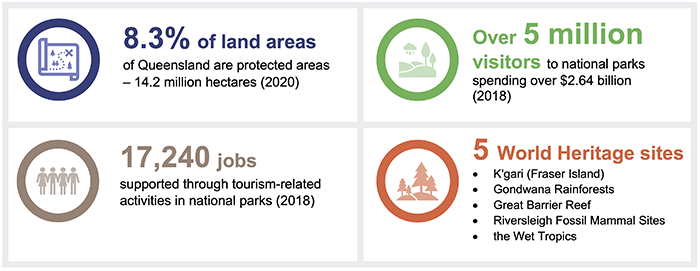
Compiled by the Queensland Audit Office using latest available information from the following sources: percentage of land area – Queensland's Protected Area Strategy 2020–2030; number of visitors to national parks and jobs supported – The University of Queensland's report on estimating the value of national parks to the Queensland economy.
Ecotourism products
The Queensland Government supports the development and operation of ecotourism facilities and activities both in and off protected areas. Ecotourism activities range from those that are government‑funded and managed – such as walking tracks, lookouts, and amenities in national parks – to those that are privately developed and operated. Many natural areas offering ecotourism activities, such as beaches, hinterlands, rainforests, and the outback, are both within and outside protected areas.
Figure 3B provides a snapshot of the types of ecotourism products in Queensland.
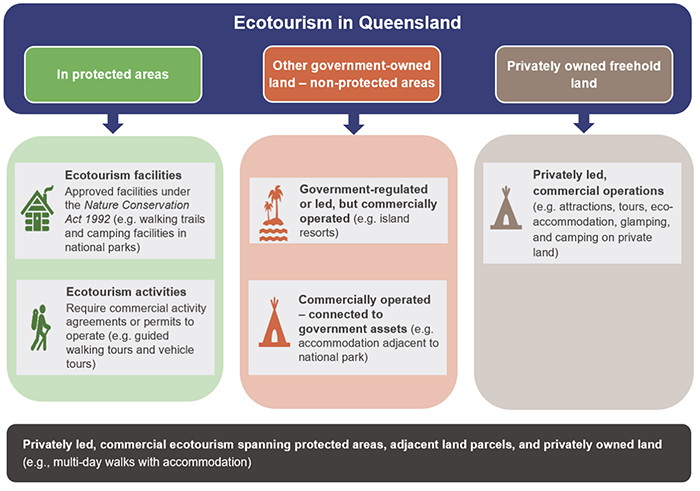
Compiled by the Queensland Audit Office from information provided by the audited entities.
Tourism operators who conduct commercial operations in Queensland’s national parks require a commercial activity permit or an agreement authorised by the Department of Environment and Science. There are currently around 480 authorised permits or agreements.
Economic value of tourism
Tourism is a significant contributor to Queensland’s economy through domestic and international visitors (the visitor economy). The visitor economy is measured by overnight visitor expenditure and market share.
Data is collected through international and national visitor surveys conducted by Tourism Research Australia (part of Austrade). The main data collected through telephone surveys includes information on destination, purpose of trip, accommodation, leisure activities, and trip expenditure.
Figure 3C shows the annual overnight visitor expenditure in Queensland compared to New South Wales and Victoria.
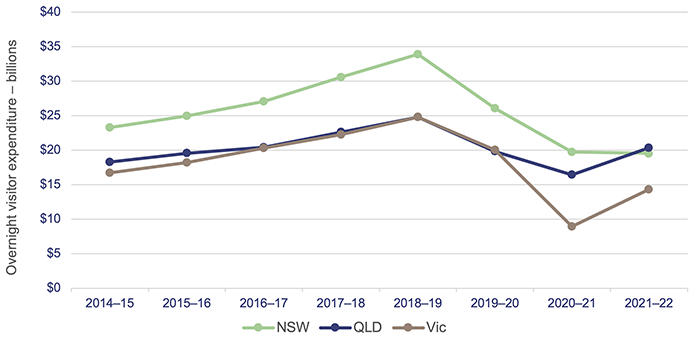
Note: NSW – New South Wales; QLD – Queensland; Vic – Victoria.
Compiled by the Queensland Audit Office using information from international and national visitor surveys conducted by Tourism Research Australia.
The total overnight visitor expenditure in Queensland in the year ended June 2022 was $20.4 billion. This was an increase of 23.9 per cent from the previous year, but down 20.2 per cent compared to the pre‑COVID-19 year ended December 2019. Due to international travel restrictions, domestic overnight visitor expenditure accounted for 97 per cent ($19.6 billion) of the total. Figure C1 in Appendix C shows the total overnight visitor expenditure by Queensland regions for the years 2018–19 and 2021–22.
Figure 3D shows that Queensland made the largest gain of the states and territories in market share (up 4.8 percentage points to 27.5 per cent) from December 2019 to June 2022.
Government roles
Achieving the Queensland Government’s vision for ecotourism requires the collaboration of many entities at federal, state, and local government levels. It also requires the government to work with regional tourism organisations, industry, and commercial businesses. Each has a different role to play.
In this audit, we have focused on the key ecotourism-related roles of the 3 Queensland Government entities listed in Figure 3E.
|
Government entity |
Primary roles relating to ecotourism |
|---|---|
|
Department of Environment and Science |
Contribute to Queensland’s economy by enabling sustainable development and promoting nature-based tourism within the protected areas. Safeguard and manage Queensland’s natural, cultural, and heritage values. |
|
Department of Tourism, Innovation and Sport |
Promote long-term growth of the tourism industry by facilitating a strategic, whole-of-government approach to planning and investment in the state's tourism infrastructure, assets, and products, and coordinating and leveraging major events to generate jobs. |
|
Tourism and Events Queensland |
Achieve economic and social benefits for the state by generating consumer demand, attracting and promoting major events, and supporting tourism experience and destination development. |
Compiled by the Queensland Audit Office using information from government annual reports and service delivery statements.
Impact of COVID-19
The COVID-19 pandemic caused severe disruptions to demand for tourism, both globally and in Australia. The industry experienced:
- a sudden halt in international visits
- restrictions on mobility within the state and country
- increased health and safety concerns.
However, the pandemic also saw an increase in demand for nature-based experiences, with people deeming them safer and more than ever wanting wide-open spaces, fresh air, and nature. The state and international border closures saw an increase in the domestic market.
In early 2021, the Queensland Government established the Tourism Industry Reference Panel, made up of 3 tourism industry experts. The panel facilitated industry engagement and worked with government entities to consider the actions required and made recommendations for positioning Queensland’s tourism industry for success after COVID‑19. This led to a new tourism strategy: Towards Tourism 2032 – Transforming Queensland’s visitor economy future, which was launched on 3 November 2022.

4. Planning and coordinating ecotourism
This chapter is about how the state’s tourism and environmental entities – the Department of Environment and Science; the Department of Tourism, Innovation and Sport; and Tourism and Events Queensland – plan, invest, and coordinate ecotourism activities in Queensland.
Clarity on ecotourism policy position needed
At present Queensland has no ecotourism strategy document. The Queensland Government also has not clarified its strategy or policy position and priorities for ecotourism. In its Towards Tourism 2032 – Transforming Queensland’s visitor economy future strategy, it has provided an aspirational vision of making Queensland a world leader in ecotourism, while conserving its natural and cultural assets. The tourism strategy includes specific actions to develop the ecotourism sector but does not provide a roadmap that outlines the direction entities must take for Queensland to achieve its vision or manage the balance between conservation and developing ecotourism for economic benefit.
The Department of Tourism, Innovation and Sport and the Department of Environment and Science (the departments) should seek greater clarity from a whole-of-government perspective on Queensland’s policy, risk appetite, priorities, and approach to ecotourism and industry development. With the absence of this clarity, the departments and the ecotourism operators are inhibited by uncertainty, inconsistent approaches, varying interpretations, and unresolved tension between development and environmental protection.
|
Recommendation 1 We recommend that the Department of Tourism, Innovation and Sport and the Department of Environment and Science, in consultation with the Department of the Premier and Cabinet, develop an overarching statewide policy position on ecotourism for both on and off protected areas that:
|
Ecotourism-related strategies and plans
Figure 4A shows strategies, plans, and reviews relating to ecotourism since 2016.
|
Queensland Ecotourism Plan 2016–2020 released Developed by the Department of Environment and Science to provide a strategic framework for stakeholders to coordinate efforts towards the sustainable development of the ecotourism industry. Plan has expired. |
|
Advancing Tourism 2016–20 released Developed by the Department of Tourism, Innovation and Sport to set the government’s directions to support the entire tourism sector. Strategy has expired. |
|
Work on Ecotourism Plan for Queensland’s Protected Areas 2023–2028 begun Draft plan to replace the expired Queensland Ecotourism Plan 2016–2020, developed by the Department of Environment and Science. The plan focuses only on protected areas and land immediately adjacent to protected areas. Due to be finalised in early 2023. |
|
Nature-based Tourism Strategy 2021–2024 and Nature Traveller Sub-segment Strategy released Developed by Tourism and Events Queensland with the aim of revitalising the Queensland nature-based tourism offering. |
|
Tourism Industry Reference Panel established The Queensland Government established an industry panel to consider the actions required and make recommendations for positioning Queensland’s visitor economy for success after COVID‑19. |
|
Interim Action Plan for Tourism Recovery released The Tourism Industry Reference Panel’s interim report, outlining the outcome of statewide consultation and a strategic framework for action. |
|
Towards 2032 – Reshaping Queensland's visitor economy to welcome the world report released The Tourism Industry Reference Panel’s final report, summarising the panel’s findings and recommendations for government and industry. |
|
Towards Tourism 2032 – Transforming Queensland’s visitor economy future released A collective strategy for government and industry that sets the direction of tourism in Queensland for the next 10 years. Developed by the Department of Tourism, Innovation and Sport in partnership with industry. |
Compiled by the Queensland Audit Office from information provided by the audited entities.
The previous tourism and ecotourism strategies both ended in 2020, coincidentally at the time the COVID-19 pandemic was having a major impact on the tourism industry.
In the absence of a coordinated unifying state ecotourism strategy, Tourism and Events Queensland and the Department of Environment and Science have developed separate strategies specific to their areas of responsibility:
- Tourism and Events Queensland’s Nature-based Tourism Strategy 2021–2024, which focuses on industry growth; and
- Department of Environment and Science’s draft Ecotourism Plan for Queensland’s Protected Areas 2023–2028, which focuses on protecting the environmental value of national parks.
In its Nature-based Tourism Strategy 2021–2024, Tourism and Events Queensland sets a target of growing the market share of domestic overnight leisure visitors to Queensland participating in nature‑based activities to 31 per cent by 2024. In September 2021 it was 28.4 per cent, based on data from international and national visitor surveys conducted by Tourism Research Australia. However, there is no whole-of-government plan on how to achieve this growth in market share.
The draft Ecotourism Plan for Queensland’s Protected Areas 2023–2028 outlines goals and actions for developing ecotourism within protected areas and facilitating new ecotourism projects on land adjoining protected areas. But there is no clear plan for how government will leverage the competitive advantage of the many other natural areas outside of protected areas.
Existing ecotourism-related strategies and plans that are publicly available do not include measurable indicators of success, thus reducing public accountability. Plans and strategies, both internal and external, need clear objectives, performance targets, and measurable indicators of success, and entities need to effectively monitor progress against them. This should also include measures of outcomes for Traditional Owners. We note that Tourism and Events Queensland has an expanded, internal version of the Nature-based Tourism Strategy that includes indicators of success and performance targets.
Ecotourism roadmap needed to guide development both within and outside protected areas
Only when the Queensland Government has clarified its strategy or policy position and priorities for ecotourism can the departments realistically develop a plan for achieving the state’s ecotourism vision.
At present the state has no plan or roadmap for how the departments will work with and support industry. Such a plan/roadmap is necessary to provide direction and a level of certainty, and to demonstrate progress.
|
Recommendation 2 Following the development of a statewide policy position on ecotourism, we recommend that:
|
Opportunities and potential projects are not strategically identified and prioritised
The lack of a clear ecotourism roadmap is affecting how potential projects are identified and prioritised. This makes it difficult to undertake a strategic assessment of ecotourism investment opportunities for both within and outside protected areas. The identification of potential projects has previously been short term and reactive. In addition, until recently, the lack of a tourism project selection framework means potential projects could not be objectively assessed against each other and prioritised.
However, both the Department of Environment and Science and the Department of Tourism, Innovation and Sport have taken actions in the last 2 years that, when fully implemented and utilised, have the potential to address this issue.
In 2021, the Department of Environment and Science engaged external contractors to investigate and compile a portfolio of suitable locations for potential ecotourism development opportunities. This included current campgrounds and areas previously disturbed within protected areas, and areas adjacent to existing protected areas with the potential to develop off-park accommodation and experiences with access to walking trails on-park.
The Department of Environment and Science has used this review to inform its investment decisions in developing national parks. The recent Activate Ecotourism Infrastructure (Act Eco) funding initiative also took account of the identified priority areas during the assessment process of ecotourism or nature-based tourism infrastructure projects adjacent to a public protected area, world heritage area, state forest, or timber reserve.
The Department of Tourism, Innovation and Sport is developing the Tourism Infrastructure Development Framework, which is an assessment framework through which state and private-led projects will be funnelled, providing a consistent approach.
The framework aims to ensure projects are strategically identified and prioritised, and the extent and nature of state involvement and associated risks are determined and resourced. However, as the Department of Tourism, Innovation and Sport is yet to implement the framework, we cannot assess how effective it will be in prioritising projects across the state – both within and outside protected areas.
There is no investment strategy to guide funding priorities
Government funding is provided for state-led ecotourism projects and for grants to private tourism operators. Since 2012, the government has invested around $14.8 million in ecotourism facilities projects in protected areas, such as eco-accommodation and multi-day walks. It has also provided around $99 million in grant funding for other ecotourism-related projects and activities. However, with no ecotourism plan or investment strategy, the level of state investment is based on a limited understanding of priorities regarding where investment is needed and for what.
The government needs to better understand the strategic demand for ecotourism projects at a regional, industry, and project level to ensure funding is effectively directed and aligned with its vision for ecotourism. A statewide policy position would identify the state’s priorities for ecotourism for both on and off protected areas and provide better direction for government funding.
The Tourism Industry Reference Panel’s Towards 2032 – Reshaping Queensland's visitor economy to welcome the world report highlighted the need for more investment and funding. One of its recommendations was to have a funding stream specific to incentivising ecotourism projects.
More recently, government established 2 additional grant programs specifically to fund ecotourism and nature-based tourism:
- The Activate Ecotourism Infrastructure (Act Eco) pilot initiative will provide financial support to Queensland tourism operators, not-for-profit organisations, and local governments to deliver ecotourism and nature-based tourism infrastructure adjacent to, or near, a protected area, world heritage area, timber reserve, or state forest.
- The $2 million Eco-certified Tourism Destination Program provides grant funding of up to $150,000 to Queensland local government authorities and regional and local tourism organisations to assist tourism destinations to achieve globally recognised certification through one of the following programs
- Ecotourism Australia – Eco Destination Certification program
- EarthCheck – Sustainable Destination Standard program.
Expressions of interest for the Activate Ecotourism Infrastructure (Act Eco) funding initiative closed in late 2022 with funding decisions made in early 2023.
Information on visitor preferences could be better used
Tourism and Events Queensland analyses and utilises data and conducts research on many aspects of the tourism industry, providing information and insights to assist government and industry stakeholders with decision-making and strategy development.
Identifying customers and what they want is vital to attracting international and domestic travellers and becoming a world leader in ecotourism. Research into traveller needs and preferences can help define tourism focuses, priorities, and goals. It can influence and guide partners in aligning activities and maximising opportunities to target consumers. However, it is unclear how well this information is currently used by government outside of Tourism and Events Queensland for planning and prioritising ecotourism strategies.
Using information to drive consumer demand
By marketing and promoting tourism in Queensland, Tourism and Events Queensland drives consumer demand and leads the development of branding for tourism. To meet growing consumer demand for nature-based experiences and in line with Queensland’s tourism brand purpose to ‘travel for good’, it has developed the Nature-based Tourism Strategy 2021–2024 and Nature Traveller Sub-segment Strategy to guide visitor growth to Queensland and increase visitation and traveller spending.
The Nature Traveller Sub-segment Strategy integrates a nature proposition into statewide marketing and promotion. The strategy spans all travel types and identifies:
- challenges and opportunities – how to capitalise on growth in demand, build Queensland’s competitive advantage, and reposition Queensland’s nature offering
- global consumer trends affecting demand for nature-based tourism – increased visitor awareness of conservation, health, and safety, and associating nature experiences with wellbeing
- what nature travellers want and need.
Tourism and Events Queensland uses these strategies to influence and guide partners (government, trade, and industry), including by:
- helping the tourism sector design and deliver experiences that meet consumer expectations
- creating resources, including practical tools and case studies, for tourism operators
- providing mentoring and training programs
- developing consumer value propositions that include nature traveller insights and using them in its marketing.
The Nature Traveller Sub-segment Strategy also provides government tourism and environmental entities with an understanding of Queensland’s nature-based tourism brand and visitor expectations. This can help in aligning government investment with visitor trends and expectations.
The Activate Ecotourism Infrastructure (Act Eco) funding initiative required applicants to demonstrate that proposed projects aligned with the Nature-based Tourism Strategy 2021–2024.
Clearer leadership of ecotourism is needed
Oversight of the various plans and strategies in place is generally at an entity level, limiting visibility across government on how ecotourism development is progressing. Relevant government entities partner with the tourism industry, Traditional Owners, and the community to support sustainable growth and deliver new ecotourism experiences. However, the respective roles of the entities involved in developing ecotourism, including the governance arrangements between them, could be clearer.
The government has now started to better define and reflect on its role in the tourism and ecotourism sector through the Towards Tourism 2032 – Transforming Queensland's visitor economy future strategy and implementation plan. But an overarching statewide policy position on ecotourism for both on and off protected areas would provide greater clarity on who is responsible for what. This would provide a framework to guide government entities and help them align their individual ecotourism-related strategies and plans, including the Nature-based Tourism Strategy 2021–2024 and the draft Ecotourism Plan for Queensland’s Protected Areas 2023–2028.
With the Department of Environment and Science leading the development of ecotourism in protected areas and the Department of Tourism, Innovation and Sport leading the development of ecotourism outside Queensland’s protected areas, accountability and oversight would be easier to manage.
Program Control Group
A program was set up in 2018 for the Department of Tourism, Innovation and Sport in partnership with the Department of Environment and Science to explore opportunities for new nature-based and ecotourism experiences. This includes the delivery of the Queensland Ecotourism Trails projects (ecotourism experiences at iconic Queensland destinations, identified by government, including within or adjacent to national parks).
The Program Control Group was formed to assist the joint project team to deliver these projects and ensure a coordinated government approach to support expansion of nature-based and ecotourism opportunities across Queensland. The multi-agency Program Control Group is co-chaired by deputy directors-general of the Department of Tourism, Innovation and Sport and the Department of Environment and Science with members from the departments of Seniors, Disability Services and Aboriginal and Torres Strait Islander Partnerships; Resources; the Premier and Cabinet; State Development, Infrastructure, Local Government and Planning; and the Wet Tropics Management Authority.
The group was established to:
- oversee the delivery of specific state-led ecotourism projects
- provide policy input, strategic direction, and support for new strategies, plans, and programs that the state will deliver to support the expansion of nature-based and ecotourism opportunities across Queensland.
However, to date the Program Control Group has only overseen specific ecotourism projects, mainly the Queensland Ecotourism Trails projects that the state is leading (see Chapter 5). There is little evidence that the group is providing strategic direction to expand the overall ecotourism sector, including off-park opportunities.
Cross-agency working group review
In April 2022, Cabinet approved the establishment of a cross-agency working group (CAWG), chaired by the Department of the Premier and Cabinet, to review whole-of-government efforts on ecotourism projects. Its focus is around proposals adjacent to national parks that have the highest probability of being developed. The group has met 3 times, the last time being August 2022. It is unclear from available documentation what progress has been made.
|
Recommendation 3 We recommend the Department of Tourism, Innovation and Sport; the Department of Environment and Science; and Tourism and Events Queensland develop, finalise, or update individual plans that clearly define how they will achieve the government’s vision of Queensland becoming a world leader in ecotourism, within their area of responsibility. This includes:
|

5. Managing ecotourism in protected areas
This chapter is about how the Department of Environment and Science manages ecotourism facilities and activities in Queensland’s protected areas.
The Department of Environment and Science manages the development and operation of ecotourism facilities and activities in protected areas in the following ways:
- evaluating, authorising, and managing proposals for ecotourism facilities
- licensing private tourism operators who provide ecotourism activities for visitors
- undertaking visitor and park management in Queensland’s protected areas in line with best practice.
Processes for assessment and approval of ecotourism facilities in protected areas are robust but complex
Legislation passed in 2013 allowed for ecotourism facilities to be developed in protected areas. To operate an ecotourism facility in a protected area, the operator needs to obtain a lease under the Nature Conservation Act 1992.
Ecotourism facilities are designed and managed to facilitate the presentation, appreciation, and conservation of the land’s natural condition and cultural resources and values. Facilities include walking trails, camping grounds, and eco-accommodation.
The Department of Environment and Science has a robust process for assessing and approving proposals for ecotourism facilities in protected areas. All proposals are evaluated against a set of statutory and merit-based assessment criteria. The statutory criteria are the legislative requirements provided in the Nature Conservation Act 1992, while the merit criteria focus on commercial aspects of proposals and suitability as tourism products at the location.
Lengthy and complex approval process
Protected areas are extremely important for biodiversity conservation including protecting threatened species and respecting the cultural and traditional ownership of First Nations people. Gaining government approval for ecotourism facilities in protected areas is complex and time consuming due to the need for greater environmental protections and to ensure the views and rights of Traditional Owners are respected.
Depending on the type of development, individual site characteristics, and tenure, proposals are subject to many approvals and authorities required under local, state, and Commonwealth legislation and planning frameworks. Individual projects face different challenges and complexities, such as the number of approvals needed and difficulties engaging with stakeholders. For example, one project had to comply with 15 different acts and codes, including the Environment Protection and Biodiversity Conservation Act 1999 (Cth), the Nature Conservation Act 1992 (Qld), the Native Title Act 1993 (Cth), and various planning acts and regulations.
The process of assessing proposals for ecotourism facilities is rigorous, to ensure ecotourism within protected areas is undertaken with minimal environmental impact, managed sustainably, and done in partnership with Traditional Owners. It is important that the approval, planning, and delivery of ecotourism facilities ensures culturally appropriate outcomes for Traditional Owners. For many proponents, meeting these requirements is onerous and costly, and they decide not to proceed with their application.
Applicants are provided with detailed information and guidance, developed by the Department of Environment and Science, on delivering ecotourism facilities in national parks. This includes the Implementation Framework: Ecotourism Facilities on National Parks and Best Practice Ecotourism Development Guidelines.
The government uses a 2-stage process for assessing lease applications, as shown in Figure 5A.
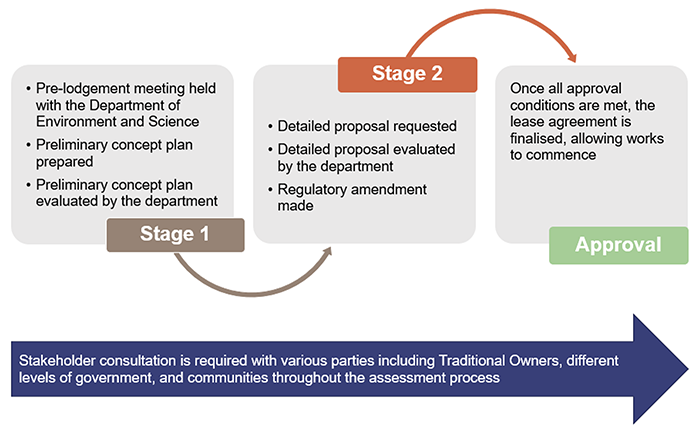
Compiled by the Queensland Audit Office using information provided by the audited entities.
The case study in Figure 5B gives an example of one of the first ecotourism projects in a Queensland national park. It took almost 6 years to obtain approval for this project. Comparison by the Department of Tourism, Innovation and Sport with 2 ecotourism facilities projects in other states shows that this time frame is not unusual. Both took 6 years or more, including 2 and 3 years respectively to undertake environmental studies and negotiate with Traditional Owners.
| Lengthy and complex approval process for ecotourism developments |
|---|
|
Project overview The Scenic Rim Trail provides walking experiences for visitors through private property and the remote mountains of Main Range National Park. It was built in partnership between the Queensland Government and a private ecotourism operator, selected through a competitive expression of interest process. Project timeline The Scenic Rim Trail project took almost 6 years, from the initial expression of interest in September 2013 to the final approval by the Department of Environment and Science (DES) in August 2019.
Challenges The initial planning documents for the project indicated that the proponent was to submit its detailed proposal for the project within 3 months of the request being released. However, it took over 3 years for this to occur. As the first ecotourism facilities project, it took time for both the government and proponent to understand and navigate the legislative and planning processes, including local and federal government approvals. This included finding ways to better engage with Traditional Owners. In 2015, a change in government led to a lengthy review of the ecotourism policy. This then delayed the government’s approval of the project’s preliminary proposal. Several changes to the proposal, including the method of waste disposal, affected the approval’s time frames, particularly the Commonwealth approval, which took 2-and-a-half years to obtain. The project had to meet several different approval requirements from various authorities. The proponent had to invest significant time, money, and effort in navigating these processes. |
Compiled by the Queensland Audit Office from information provided by the Department of Environment and Science.
Despite an expression of interest process for ecotourism facilities in protected areas in 2013, there was limited progress in advancing proposals through to construction between 2013 to 2017. The government commissioned 2 reviews of the expression of interest process. Both made recommendations, resulting in actions to simplify the development process for proponents. Improvements implemented include:
- Department of Tourism, Innovation and Sport managing the expression of interest and procurement processes and negotiations with Traditional Owners
- Department of Environment and Science being the assessor of Queensland Ecotourism Trails program
- developing assessment and leasing templates to assist with probity and transparency
- introducing a 2-stage process whereby only viable proponents progress to a full assessment.
In 2018, the Department of Tourism, Innovation and Sport and the Department of Environment and Science responded to the challenges faced by proponents by forming a Project Control Group to provide direct delivery support for ecotourism projects. The Program Control Group oversees the delivery of ecotourism projects in protected areas; regularly reviewing project status, delivery schedules, budgets, and overall risks.
With these projects, the government is leading key aspects of the assessment and approval processes, such as engaging with the Traditional Owners and coordinating all state and Commonwealth environmental approvals. However, while there have been some improvements in how government entities coordinate these processes, there are still some key issues and challenges. These include difficulties in managing stakeholder relationships including with Traditional Owners, and a lack of clarity about what the projects are trying to achieve. More recently, the Project Control Group has introduced independent reviews at key decision points of projects in development.
Five approved ecotourism facilities from 30 proposals
The Department of Environment and Science has considered 30 proposals for ecotourism facilities on or adjacent to protected areas in the last 10 years. Five of these were approved and completed – 3 in protected areas, and 2 in non-protected areas, but where the state is a trustee of the land. A further 2 facilities projects have been approved and are currently in development – Wangetti Trail (from Palm Cove to Port Douglas) and Cooloola Great Walk (from Noosa North Shore to Rainbow Beach). The department is also in advanced stages of assessing 7 more proposals for ecotourism facilities.
Figure 5C shows the status of the 30 proposals for ecotourism facilities considered by the Department of Environment and Science. We found no complete list of ecotourism proposals or projects government has considered outside of protected areas.
|
|
Protected area |
Non-protected area |
Protected and non-protected area |
Total |
|---|---|---|---|---|
|
Approved |
3 |
2 |
- |
5 |
|
In progress – under assessment |
7 |
- |
2 |
9 |
|
Not progressed – denied by government |
4 |
2 |
1 |
7 |
|
Not progressed – withdrawn by proponent |
4 |
- |
2 |
6 |
|
Under investigation – initial consultation phase |
2 |
- |
1 |
3 |
|
Total |
20 |
4 |
6 |
30 |
Compiled by the Queensland Audit Office from information provided by the Department of Environment and Science.
Figure 5D lists the 5 approved ecotourism facilities projects, including date of commencement and funding contributed by government. Additional investment is provided by the proponent.
|
Project |
Project type |
Land type |
Began operating |
Government funding contribution |
|---|---|---|---|---|
|
Mamu Tropical Skywalk |
Skywalk |
Protected area |
March 2014 |
$10,000,000 |
|
Spicers Scenic Rim Trail |
Eco-accommodation and multi-day walk |
Protected area |
June 2020 |
$2,500,000 |
|
O’Reilly’s Campground |
Eco-accommodation and multi-day walk |
Protected area |
September 2020 |
$1,210,000 |
|
Walkabout Creek Adventures/Riverlife |
Ecotourism experience |
Non-protected area |
September 2016 |
Nil |
|
East Trinity |
Ecotourism Indigenous experience |
Non-protected area |
July 2021 |
$1,100,000 |
Compiled by the Queensland Audit Office from information provided by the Department of Environment and Science and the Department of Tourism, Innovation and Sport.
|
Recommendation 4 We recommend the Department of Environment and Science, in consultation with the Department of Tourism, Innovation and Sport:
|
Completed ecotourism projects are monitored
Monitoring, evaluating, and reporting on activities are all critical in supporting the effective and efficient delivery of programs and in achieving the desired outcomes. The Department of Environment and Science and the Department of Tourism, Innovation and Sport have established appropriate processes and practices for overseeing completed ecotourism projects.
Assurance framework in place to guide monitoring and reporting
In 2021, the 2 departments developed a framework to guide the monitoring, evaluating, and reporting of the ecotourism program – the Queensland Ecotourism Program Assurance Framework.
In March 2022, the Department of Environment and Science conducted an annual review of the 3 completed ecotourism projects in line with the assurance framework. Overall, the review highlighted that the projects’ operators had demonstrated appropriate compliance with the conditions of the leases.
Providing ecotourism in national parks
Queensland’s protected areas, including national parks and forests, underpin the state’s nature-based tourism industry, attracting millions of international and domestic visitors each year. The Department of Environment and Science manages all aspects of protected areas, in partnership with Traditional Owners, including identifying and providing sustainable nature-based recreation and tourism, while respecting the importance of the First Nations culture and heritage.
The department’s investment includes upgrading visitor facilities and improving visitor experiences in the state’s more popular and highly visited national parks. The department also delivers different ecotourism products and experiences through social media, digital communication tools, and Gateway Visitor Centres. These centres deliver conservation education and experiences to visitors.
Ecotourism activities
Licenced tourism operators can provide ecotourism activities on protected areas. In addition to camping, certain activities affecting Queensland's parks and forests need a permit. These activities include recreational and commercial tours; scientific or educational research; filming and photography; and organised events such as trail running, climbing, and canoeing.
Tourism operators wanting to conduct commercial activities in Queensland’s national parks need to apply and be approved for a commercial activity permit or agreement authorised by the Department of Environment and Science. There are currently 488 commercial permits or agreements in national parks, with 309 of those for guided tours.
The permit system ensures that the management of protected areas and their use is ecologically sustainable. Permits are required so that the department can regulate aspects of where, what, and when activities occur, and to what extent.
Operators who obtain a permit are required to submit a return of operations on a regular basis. This includes visitor numbers used to determine daily site fees payable for each visitor on the commercial tour.
Park access fees can help fund ecotourism
While Queensland charges fees for camping, entry to Queensland’s national parks is free. All Australian jurisdictions except Queensland and Victoria charge a fee for visiting national parks. Park access fees can be a source of additional funding and income for national parks to help subsidise infrastructure maintenance and operations. They include seasonal passes or other ‘day use’ fees.
The government-appointed Tourism Industry Reference Panel, in its Towards 2032 – Reshaping Queensland's visitor economy to welcome the world report, recommended the state consider new mechanisms to obtain additional funding to support and grow the visitor economy. This included introducing fees and charges to recoup running costs and to be reinvested in our national parks and protected areas. Government has committed to investigating revised fee regimes for protected area access by 2026. However, any proposal to charge users to access national parks in Queensland requires legislative amendment, which the government has not previously supported.
Figure 5E provides an example of how one Australian jurisdiction charges visitor fees for a national park and reinvests the funds received into the park.
| Using visitor fees to invest in a national park |
|---|
|
Kakadu National Park Kakadu National Park, in the Northern Territory, is one of Australia's largest national parks. Kakadu’s Traditional Owners manage the park in partnership with Parks Australia (Australian Government). Visitor levies Park passes are required to visit the national park and are valid for 7 days. The cost of these varies depending on the season, with higher prices during the dry season from May to October. Prices range from $20 for children to $40 for adults (as of October 2022). Park passes are free for Northern Territory residents. Use of visitor levies The national park’s operator uses the money raised from visitor levies to maintain its facilities, preserve its World Heritage sites, and support Traditional Owners and their community: How visitor levies are used Revenue from park passes only covers 7 per cent of Kakadu’s running costs. The rest of its funding comes directly from the Australian Government. |
Compiled by the Queensland Audit Office using information from Parks Australia.

